Nearshore application development is vital for established companies or startups, enabling progress and creativity. Its advantages, proximity, cost-effectiveness, and effective communication revolutionize the software development landscape.
To thrive in this ever-changing industry, staying informed about the latest trends in nearshore application development is essential. With competition, diverse client demands, and advancing technology, businesses must proactively leverage nearshore partnerships for sustained success.
Aloa, an expert in software outsourcing, navigates the ever-changing software solutions landscape. We have a deep understanding of nearshore application development. Our services are designed to empower businesses and startups, offering everything from initial minimum viable product (MVP) development to crafting intricate, user-centric nearshore applications. We bring expertise to every stage of nearshore development, creating solutions that resonate with your users and drive your business forward.
In this blog, we'll look at the latest trends in nearshore application development for 2023. We'll provide clear examples, statistics, and how to stay ahead of the curve.
Afterwards, you'll find essential insights to excel in the dynamic world of nearshore application development. Stay ahead and benefit from nearshore advantages for significant business growth. Partnering with us opens excellent opportunities for your enterprise.
Let’s jump in!
What is Nearshore Application Development?
Nearshore application development, also known as nearshore software outsourcing, is a software development outsourcing model that involves partnering with a neighboring country with similar time zones and cultural similarities.
This approach offers several benefits, including access to a diverse talent pool, years of experience, and cultural knowledge. Moreover, companies can benefit from dedicated project managers and services from a software development team while minimizing travel expenses and language barriers.
Companies can achieve greater collaboration, communication, and flexibility by working with nearshore development teams than traditional offshoring models. The team's proximity to the United States means they are better suited to handle real-time issues and concerns that may arise during the project's lifecycle.
Additionally, nearshore teams better understand the business culture and regional regulations, allowing them to provide more targeted solutions while also reducing travel costs and offering a wide range of services.
Choosing the right nearshore partner is crucial for success. A reliable partner should have experience in your industry or domain and be transparent about their processes and methodologies. They should also have excellent communication skills and understand the importance of timely delivery.
Overall, nearshore application development offers an effective solution for companies outsourcing software development tasks while collaborating closely with their development partners.
5 Nearshore Application Development Trends and Stats To Watch For in 2023
Remaining at the forefront of technology is not just an advantage – it’s a necessity. Today, one of the most influential shifts reshaping the software development landscape is nearshore application development. Let's explore some significant trends and statistics that have the potential to influence the direction of growth in 2023.
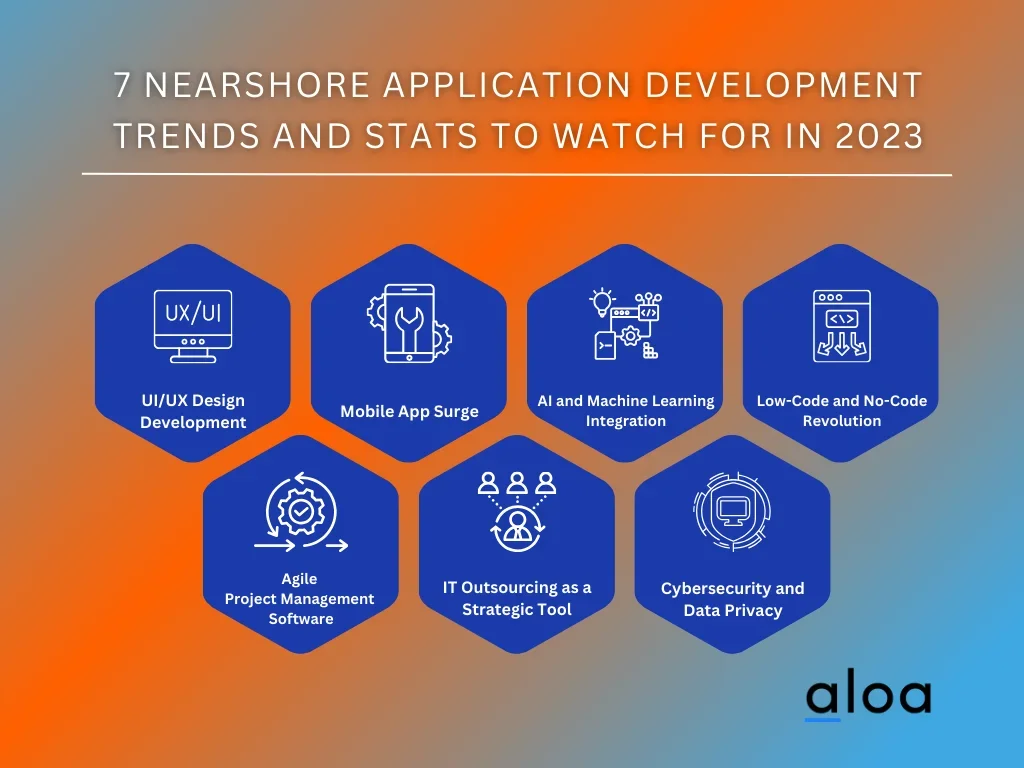
Trend 1: UI/UX Design Development
UI/UX design development creates visually appealing and user-friendly app interfaces. Nearshore software development companies employ UI/UX experts to enhance the user experience, improving customer satisfaction and adoption rates. Incorporating UI/UX design principles helps apps stand out in a competitive market. Custom UI/UX design services cater to specific business requirements, enabling companies to create user-centric mobile apps that drive success.
Research by Soussan Djamasbi demonstrated substantial enhancements in online platforms after optimizing mobile user interfaces through UI/UX development, leading to a 30% increase in sales, a 50% reduction in bounce rates, and a 70% increase in product sales.
Nearshore application development transforms UX/UI design by:
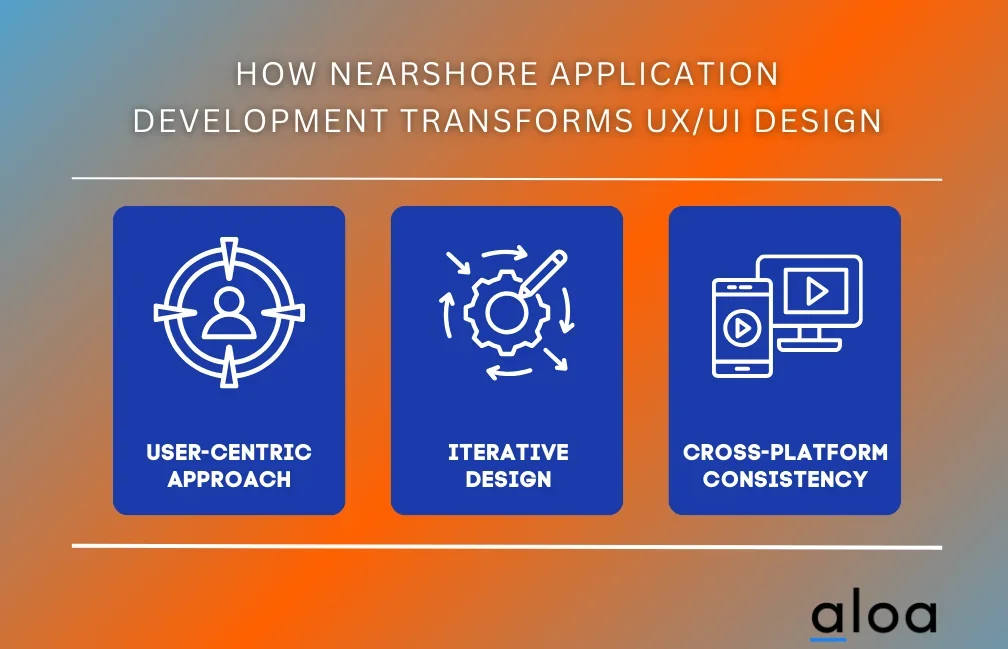
- User-Centric Approach: UI/UX design puts users at the center of the development process. Nearshore companies conduct user interviews, create personas, and analyze user behavior to design applications that align with users' needs and behaviors.
- Iterative Design: Nearshore teams adopt iterative design methodologies, continuously refining UI/UX based on user feedback. This iterative approach allows constant improvements, ensuring the application evolves to meet changing user demands.
- Cross-Platform Consistency: UI/UX design ensures consistency across different platforms and devices. Nearshore applications are designed to provide a uniform experience, whether users access the application on a desktop, tablet, or mobile device.
Businesses can align their products closely with user expectations by understanding user interactions and integrating the latest UX/UI trends. This integration improves user satisfaction, provides a competitive advantage, boosts engagement, enhances conversion rates, ensures adaptability to new technologies, and fosters effective global collaboration. These advancements contribute significantly to the industry's growth and reputation for delivering exceptional user-centered applications.
Considerations for Implementing UI/UX Design in Nearshore Application Development
Implementing UI/UX design in nearshore application development requires a deep understanding of user needs through research methods like interviews and usability testing. Collaboration among designers, developers, and stakeholders is vital to align design vision with technical feasibility and business goals.
The approach should be user-centric, utilizing personas and journey maps to create intuitive and seamless user experiences. Effective communication and iterative feedback loops ensure continuous improvements, enhancing the application's usability and overall user satisfaction.
Trend 2: Mobile App Surge
The demand for mobile apps is increasing, resulting in a rise in nearshore app development companies. These companies specialize in developing iOS, Android, and cross-platform apps.
They offer services from design and development to testing and app store submission. Nearshore app developers stay current with industry trends and tailor their services to meet business objectives, user expectations, and target audiences.
According to Statista, the trend towards mobile applications is evident in the vast number of available apps. The forecast indicates substantial growth in download numbers across all segments in 2027, a trend observed consistently from 2019 to 2027.
The data suggests a continuous increase in downloads across various sectors. Specifically, the Games segment is anticipated to peak with 176.1 million downloads in 2027. This number continues to grow daily.
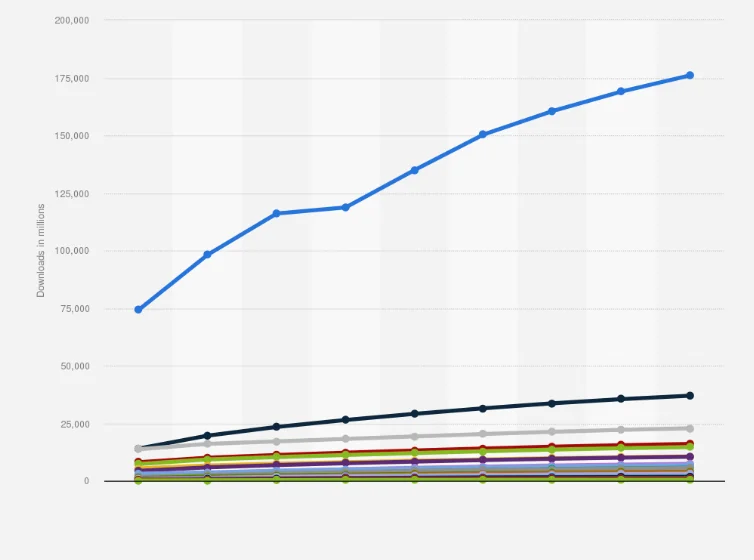
Nearshore application development is undergoing a transformation driven by various factors:
- Agile and DevOps Practices: Nearshore development teams leverage Agile methodologies and DevOps practices, enhancing collaboration, flexibility, and continuous improvement. These methodologies enable teams to deliver high-quality applications, swiftly adapting to evolving requirements efficiently.
- Advanced Collaboration Tools: Utilizing sophisticated tools like Slack, Asana, and Jira is essential for nearshore teams. These platforms facilitate real-time communication, task tracking, and seamless collaboration, regardless of team members' locations. By streamlining workflows, enhancing transparency, and improving project management efficiency, these tools are integral to the process.
- Security Measures: In the digital landscape, robust security practices are fundamental. Nearshore development teams prioritize secure coding, encryption techniques, and adherence to data protection regulations. Ensuring application and data security is paramount, addressing data breaches and privacy violation concerns.
Considerations for Implementing Nearshore Mobile App Development
Implementing nearshore mobile app development requires careful consideration of cultural compatibility, including language proficiency and cultural alignment. Choosing a location with a suitable time zone overlap is crucial for effective communication and collaboration.
Assess the technical expertise of the nearshore team through their skills, experience, and previous work. Establish robust legal agreements to protect data security and intellectual property rights. Utilize efficient project management tools and processes to facilitate seamless collaboration and ensure the success of the mobile app development project.
Trend 3: AI and Machine Learning Integration
Nearshore app development companies use artificial intelligence AI and machine learning to create intelligent apps. This integration enhances app functionality, personalization, automation, and predictive capabilities.
With their expertise in implementing AI and machine learning models, nearshore app developers provide valuable insights, automate processes, and deliver personalized app experiences. This trend has revolutionized how companies gain insights and stay competitive.
The global artificial intelligence market was valued at USD 136.55 billion in 2022 and is projected to expand at a compound annual growth rate (CAGR) of 37.3% from 2023 to 2030.
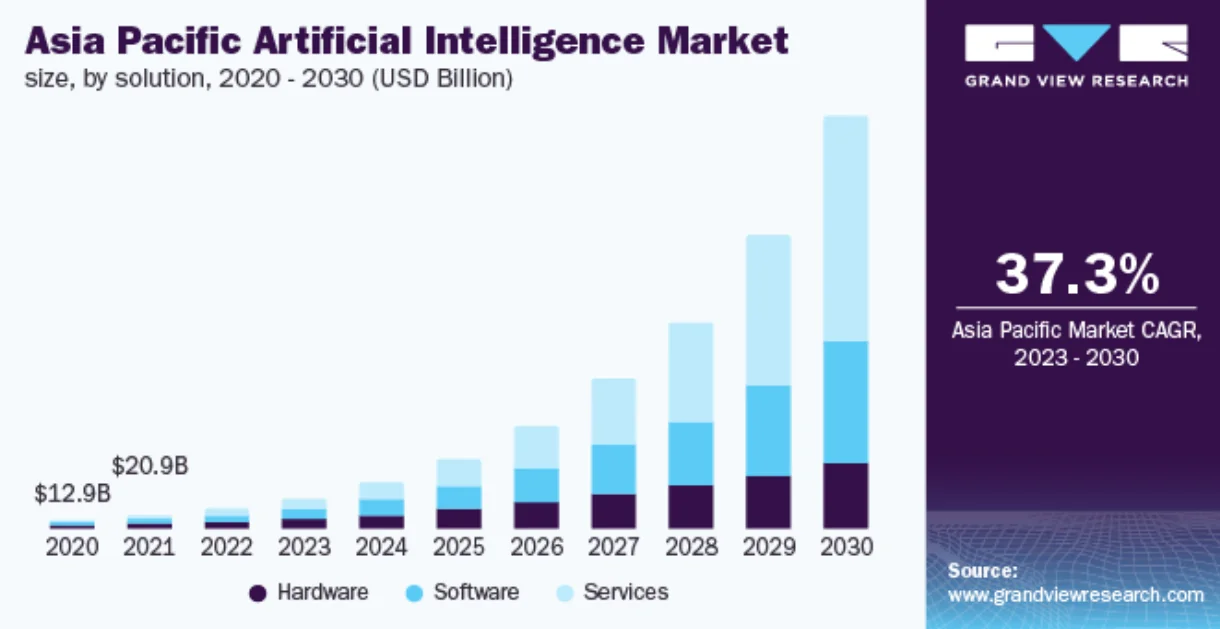
AI and machine learning transform the nearshore application development industry through:
- Enhancing Efficiency: Automating tasks and streamlined workflows significantly improve the efficiency of software development processes, enabling nearshore developers to deliver high-quality applications faster and more effectively.
- Personalizing User Experiences: AI-driven applications provide personalized interactions and real-time support, increasing user satisfaction. This personalization enhances user engagement and loyalty, crucial factors in the success of any application.
- Strengthening Security: Advanced algorithms enhance security measures, identifying vulnerabilities and predicting potential risks. This proactive approach to security makes applications more resilient to cyber threats, ensuring a safer user experience and protecting sensitive data.
Considerations for Implementing AI and Machine Learning
When integrating AI and machine learning in nearshore app development, prioritize technical expertise, emphasizing skills in AI technologies and software engineers. Seamless communication through efficient tools is vital, alongside a focus on ethical AI practices and data privacy compliance. Adopt collaborative project management methods like Agile for iterative development and ensure legal agreements safeguard intellectual property and data security for software engineers.
Trend 4: Low-Code and No-Code Revolution
The low-code and no-code revolution has simplified app development for nearshore companies. With these platforms, app development is accelerated, streamlined, and cost-effective. Nearshore app developers can use pre-built modules, drag-and-drop interfaces, and visual tools for rapid growth. This also empowers business users to contribute directly to the process.
The market research report highlights the growing demand for these platforms, projecting a surge to $345 billion by 2030 from $26 billion in 2022, providing essential data for strategic decisions and identifying lucrative opportunities in this dynamic industry.

These platforms are significant because they empower people with limited coding experience to develop advanced nearshore applications. This trend is substantial due to:
- Accessibility: These platforms empower non-technical individuals, fostering diversity and innovation in software development.
- Rapid Development: User-friendly interfaces and pre-built components enable swift application creation, meeting the demands for quick deployment.
- Enhanced Collaboration: Clear interfaces facilitate effective communication, ensuring active client participation, higher satisfaction, and successful project outcomes.
Considerations for Implementing Low-Code and No-Code Development Platforms
When implementing low-code and no-code development platforms in nearshore app development, assess the team's platform expertise and prioritize seamless communication. Choose a scalable platform, emphasize security, and ensure compliance with data regulations. Provide training for in-house teams to enhance self-sufficiency and reduce dependency on external developers.
Trend 5: Cybersecurity and Data Privacy
In nearshore app development, cybersecurity and data privacy are top priorities. Companies adhere to best practices, industry standards, and data protection regulations. They implement secure coding, encryption, vulnerability assessments, and secure app hosting measures.
Security audits, fast development processes, and software development services are also provided. Certifications like ISO 27001 are essential when selecting a nearshore app development partner. Ensuring user data safety and privacy is crucial in today's digital landscape.
The global cyber security market is projected to reach $326.4 billion by 2027, with a compound annual growth rate (CAGR) of 10.0% from 2020 to 2027. Managing digital resources, especially in IT security and asset management, remains a significant concern, propelling the market forward.
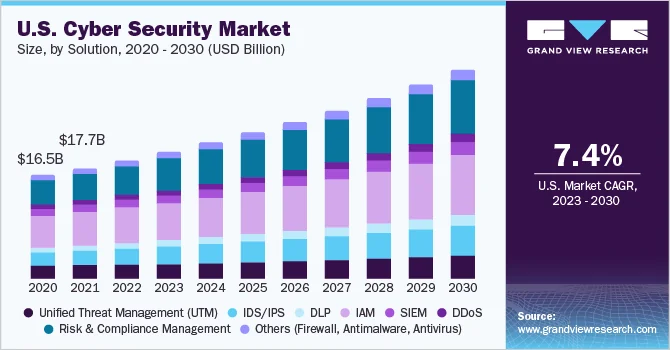
The Cybersecurity and Data Privacy trend is reshaping nearshore application development by:
- Heightened Security Demands: The surge in cyber threats necessitates robust security measures in nearshore application development. Companies are compelled to prioritize cybersecurity protocols, transforming the industry by integrating advanced security features into applications and ensuring data protection and client trust.
- Focus on IoT Integration: With the growth of IoT devices, nearshore application developers must adapt by creating applications compatible with interconnected devices. This transformation demands expertise in IoT protocols and integration, reshaping development practices to cater to the expanding IoT landscape.
- Agile Development Practices: To combat evolving cyber threats, nearshore application development adopts agile methodologies. Agile practices facilitate rapid iterations, allowing developers to promptly address security vulnerabilities and adapt to changing threat landscapes, ensuring applications remain resilient and secure.
How Nearshore Application Development Experts Handle Cybersecurity Issues?
Security poses a significant challenge in nearshore software development. Given the geographic distance between the development team and the client, ensuring the safety of customer data becomes complex. There's a constant risk of data theft or leakage. Nearshore application development experts handle these issues by:
- Implementing Robust Security Protocols: Nearshore experts enforce strict security practices, such as secure coding standards, encryption, and access controls, to safeguard customer data and applications from potential threats.
- Continuous Monitoring and Prompt Response: Experts employ advanced monitoring tools to detect security threats in real time. Their ability to respond promptly to any security incident ensures proactive management of risks and minimizes potential damage.
- Compliance and Legal Adherence: Nearshore teams stay updated with international data protection laws and regulations, ensuring compliance with legal requirements. Adhering to these regulations protects customer data and maintains the trust of clients and end-users.
Considerations for Implementing Cybersecurity and Data Privacy
Ensure clear communication, robust encryption, and access controls when implementing cybersecurity and data privacy in nearshore app development. Adhere to international data protection regulations, conduct regular security audits, and establish rapid incident response protocols. Cultivate a security-aware culture through training and maintain up-to-date security measures to counter evolving threats effectively.
How to Stay Ahead of the Curve In Nearshore Application Development Trends
The nearshore application development industry has experienced a significant transformation in recent years, particularly in response to the growing demand for efficient software solutions. With the integration of cutting-edge technologies, nearshore development teams are reshaping the software development landscape. Here are five key steps to keep you at the forefront:

Continuous Learning
To excel in nearshore app development, embrace continuous learning. Stay updated on the latest trends and technologies, incorporate best practices, and network with experts. Continuous learning enhances skills and fosters a growth mindset for constantly improving nearshore app development.
Proactive Communication
Open and transparent communication is crucial in app development teams. Share updates, challenges, and successes proactively to keep everyone engaged. Regular check-ins ensure alignment and prompt resolution of concerns. Encourage feedback, listen actively, and foster collaboration for successful projects—open communication channels for optimal outcomes.
Cultural Understanding
Fostering an inclusive and collaborative culture within app development teams requires recognizing and appreciating cultural differences. Diversity brings different perspectives and ideas that enhance the development process. Understanding cultural nuances avoids misunderstandings and improves communication. Building solid relationships by valuing cultural backgrounds strengthens team dynamics. Prioritizing cultural understanding creates a cohesive and productive nearshore team with diverse talent.
Agile Methodology
To ensure successful app development projects, embracing the Agile methodology is essential. Breaking down tasks into smaller iterations, prioritizing them based on business value and customer needs, and fostering collaboration among developers, designers, and stakeholders can significantly improve the development process.
Continuous iteration, testing, and gathering feedback allow for constant improvement. The Agile methodology makes projects more efficient, adaptable, and responsive to changing requirements. It's a proven approach gaining popularity for delivering high-quality software solutions.
Quality Assurance
To ensure a high-quality app, implement a robust quality assurance process. Thorough testing, including unit, integration, and user acceptance testing, is essential for functionality and performance. Prioritize bug fixing and software optimization to deliver an error-free app that meets user expectations. Adhering to industry standards and best practices is crucial for providing top-notch app development services in Latin America, Eastern Europe, and other regions.
Key Takeaway
Keeping pace with the evolving landscape of nearshore application development is vital in today's technology-driven world. The year 2023 promises significant growth opportunities in this sector, urging businesses to adopt and leverage the power of nearshore solutions. Nearshore application development streamlines processes, enhances user experiences, and boosts productivity for enterprises.
You can benefit from efficient collaboration, real-time communication, and cost-effective solutions by integrating nearshore models into your development strategy. Despite challenges, this approach ensures the creation of high-quality applications tailored to diverse user needs and varying internet connections.
Embracing nearshore application development isn't just a trend—it's a fundamental necessity for businesses aiming to thrive in the competitive tech landscape of today. To explore the vast potential of nearshore solutions for your business, contact us at [email protected].

